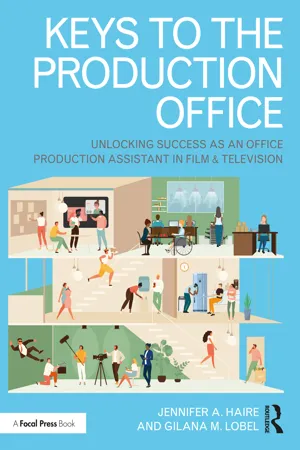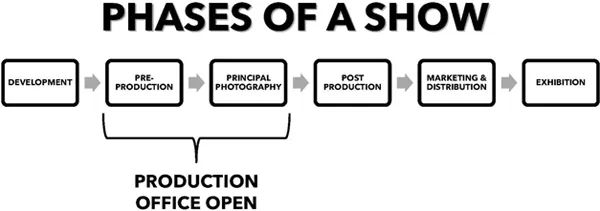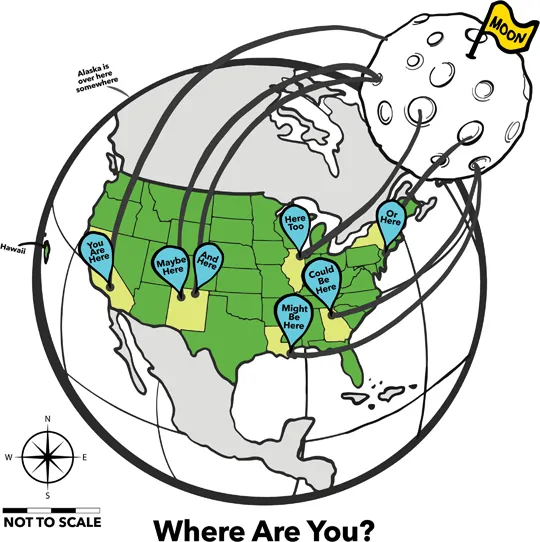
Keys to the Production Office
Unlocking Success as an Office Production Assistant in Film & Television
Jennifer A. Haire, Gilana M. Lobel
- 258 pages
- English
- ePUB (mobile friendly)
- Available on iOS & Android
Keys to the Production Office
Unlocking Success as an Office Production Assistant in Film & Television
Jennifer A. Haire, Gilana M. Lobel
About This Book
Opening a door to the real behind-the-scenes of a film or television show, this book explores the reality of working in the Production Office as an Office Production Assistant. Drawing on over 40 years' combined experience, authors Jennifer A. Haire and Gilana M. Lobel map out a career path into the industry by providing comprehensive practical information designed specifically for individuals pursuing the entry level role of the Office PA.
An invaluable tool for both breaking into the industry and on the job, the book is full of detailed "how to" information that not only provides an overview of the full scope of the industry, but also functions as a user's manual for Production Office operations. Haire and Lobel outline variations of the job of an Office PA nationwide, for both big- and small-budget feature films and television shows, and how you are a vital component of the Production team which can open the door to your future career. With coverage on how the Office PA supports the process of creating a show, the Production staff and crew, the practical day-to-day of the office, and developing your career, this is an essential resource for anyone wishing to take their first steps into the film and television industry. Featuring charts, graphics, diagrams, sample documents, templates, supplemental materials, and lighthearted cartoons throughout the book, the reader is immersed in real-world scenarios which create a solid foundation for how to be a professional in the workplace.
This is an inspiring and practical manual that reveals what is beyond the behind-the-scenes of film and television production. It's ideal for aspiring film and TV professionals with little to no experience working in Physical Production as well as readers studying film and television production courses and industry training programs.
Frequently asked questions
Information
1YOU ARE HERE
PHASES OF A SHOW

1. Development and Financing | |
Formally: The first stages of a new project, asks: What is the product being made? This is the “business” of show business. | Translation: What story do I want to tell? How will I pay for it? |
Includes: Finding and securing the rights to a story | Has this story ever been told? I need to get permission to tell a true story. |
Hiring the screenwriter/writing the script | I need a script to film. Who will write it? |
Attaching elements | Who is going to star in it? Can I get my favorite celebrity to act in it and the director of my favorite movie to direct? |
Securing pre-sales and financing | Maybe some foreign country will give me money in advance if I can get Tom Cruise to star. Can I get an advance on my inheritance? |
2. Pre-Production | |
| Formally: The process of formulating the plan for how the project will be created. | Translation: How are we going to film this thing? Plan your work, work your plan. |
Includes: Building a schedule and budget | How much does this cost to make and how long will it take to film? |
Casting | Who's playing the role of the taxi driver? |
Hiring crew | Who is going to help bring this project to life? |
Creating the look of the show | How are we going to make Brooklyn look like the 1940s? |
Finding filming locations | Where will the project be filmed? |
Setting up the Production Office | We'll need desks, phones, Internet, coffee… |
Renting equipment | Cameras, lights, lighting support, trailers, etc. |
Creating the production plan to complete principal photography | What is the most efficient way to capture this story while maintaining creative integrity? How do we film this with the team we have on this budget? |
3. Principal Photography | |
Formally: The process of filming the script. | Translation: “Roll camera… Action!” |
Includes: Ongoing prep, support of principal photography, and wrap | Facilitating the needs of the set, continual advance work for the upcoming days/weeks of filming, and, when finished, closing down anything that has been completed. |
Navigating challenges | Putting out fires, managing egos, making sure the camera can keep rolling |
4. Post Production | |
Formally: The processes of finishing a film. Telling the final story. | Translation: Piecing together everything that was filmed, creating anything that wasn't, removing anything that isn't needed or wasn't supposed to be filmed and adding color, sound, and music. |
Includes: Picture Editing | Piecing the story together scene by scene. |
Sound Design and Sound Editing | Fixing any sound problems, adding “real life” sounds, creating the complete audio/listening experience. |
Music score and rights | Creating emotion through music. Cue the orchestra! Can we get permission to use that hit song? |
Visual Effects | Wow! Did they really film this in outer space? No, we didn't actually film on Mars, it's computer-generated. |
Color Correction | Adding atmosphere and emotion to shots through color. Fixing the color of the images to match or look more stylistic. |
Final delivery | Ok, we're done. It's a masterpiece. “I'd like to thank the …” |
5. Marketing and Distribution | |
Formally: Determining the best marketing campaign to advertise the project to audiences. AND Selling or licensing the film to worldwide release or distribution platforms (theater chain owners, streaming services, television broadcast networks). | Translation: “That Instagram ad for a free slushie totally made me want to see that movie, you know, the one with the snow … and cold.” Or, “Gosh, every city bus seems to have that Big Actor's face all over it. Maybe I should go see their movie.” Where the film can be seen. Who is buying the show? |
6. Exhibition | |
Formally: The show is available to viewers on a specific date, platform, and for a duration of time. | Translation: Meet me at Big Movie Complex at 7 p.m. to see the movie! Or let's stay in and binge Hit TV Drama when it drops on Sunday. |
WHERE ARE YOU?
Production Hubs

- Albuquerque and Santa Fe, New Mexico
- Atlanta, Georgia
- Chicago, Illinois
- Los Angeles, California
- New Orleans, Louisiana
- New York, New York